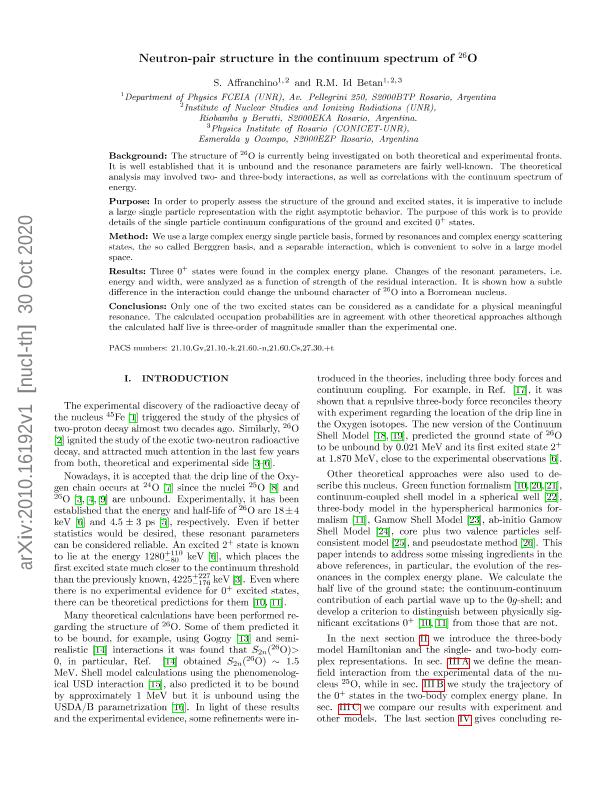Mostrar el registro sencillo del ítem
dc.contributor.author
Affranchino, Santiago

dc.contributor.author
Id Betan, Rodolfo Mohamed

dc.date.available
2023-01-05T23:15:25Z
dc.date.issued
2020-10
dc.identifier.citation
Affranchino, Santiago; Id Betan, Rodolfo Mohamed; Neutron-pair structure in the continuum spectrum of O 26; American Physical Society; Physical Review C: Nuclear Physics; 102; 4; 10-2020; 1-7
dc.identifier.issn
2469-9985
dc.identifier.uri
http://hdl.handle.net/11336/183642
dc.description.abstract
Background: The structure of O26 is currently being investigated on both theoretical and experimental fronts. It is well established that it is unbound and the resonance parameters are fairly well known. The theoretical analysis may involved two- and three-body interactions as well as correlations with the continuum spectrum of energy. Purpose: In order to properly assess the structure of the ground and excited states, it is imperative to include a large single-particle representation with the right asymptotic behavior. The purpose of this paper is to provide details of the single-particle continuum configurations of the ground and excited 0+ states. Method: We use a large complex energy single-particle basis, formed by resonances and complex energy scattering states, the so-called Berggren basis, and a separable interaction, which is convenient to solve in a large model space. Results: Three 0+ states were found in the complex energy plane. Changes in the resonant parameters, i.e., energy and width, were analyzed as a function of strength of the residual interaction. It is shown how a subtle difference in the interaction could change the unbound character of O26 into a Borromean nucleus. Conclusions: Only one of the two excited states can be considered as a candidate for a physical meaningful resonance. The calculated occupation probabilities are in agreement with other theoretical approaches although the calculated half-life is three orders of magnitude smaller than the experimental one.
dc.format
application/pdf
dc.language.iso
eng
dc.publisher
American Physical Society

dc.rights
info:eu-repo/semantics/openAccess
dc.rights.uri
https://creativecommons.org/licenses/by-nc/2.5/ar/
dc.subject
Neutron pair
dc.subject
Gamow states
dc.subject
Complex energy Shell Model
dc.subject
Drip line
dc.subject.classification
Física Nuclear

dc.subject.classification
Ciencias Físicas

dc.subject.classification
CIENCIAS NATURALES Y EXACTAS

dc.title
Neutron-pair structure in the continuum spectrum of O 26
dc.type
info:eu-repo/semantics/article
dc.type
info:ar-repo/semantics/artículo
dc.type
info:eu-repo/semantics/publishedVersion
dc.date.updated
2021-09-06T20:58:42Z
dc.identifier.eissn
2469-9993
dc.journal.volume
102
dc.journal.number
4
dc.journal.pagination
1-7
dc.journal.pais
Estados Unidos

dc.description.fil
Fil: Affranchino, Santiago. Consejo Nacional de Investigaciones Científicas y Técnicas. Centro Científico Tecnológico Conicet - Rosario. Instituto de Física de Rosario. Universidad Nacional de Rosario. Instituto de Física de Rosario; Argentina
dc.description.fil
Fil: Id Betan, Rodolfo Mohamed. Consejo Nacional de Investigaciones Científicas y Técnicas. Centro Científico Tecnológico Conicet - Rosario. Instituto de Física de Rosario. Universidad Nacional de Rosario. Instituto de Física de Rosario; Argentina
dc.journal.title
Physical Review C: Nuclear Physics

dc.relation.alternativeid
info:eu-repo/semantics/altIdentifier/doi/http://dx.doi.org/10.1103/PhysRevC.102.044330
dc.relation.alternativeid
info:eu-repo/semantics/altIdentifier/url/https://journals.aps.org/prc/abstract/10.1103/PhysRevC.102.044330
dc.relation.alternativeid
info:eu-repo/semantics/altIdentifier/url/https://arxiv.org/abs/2010.16192
Archivos asociados
